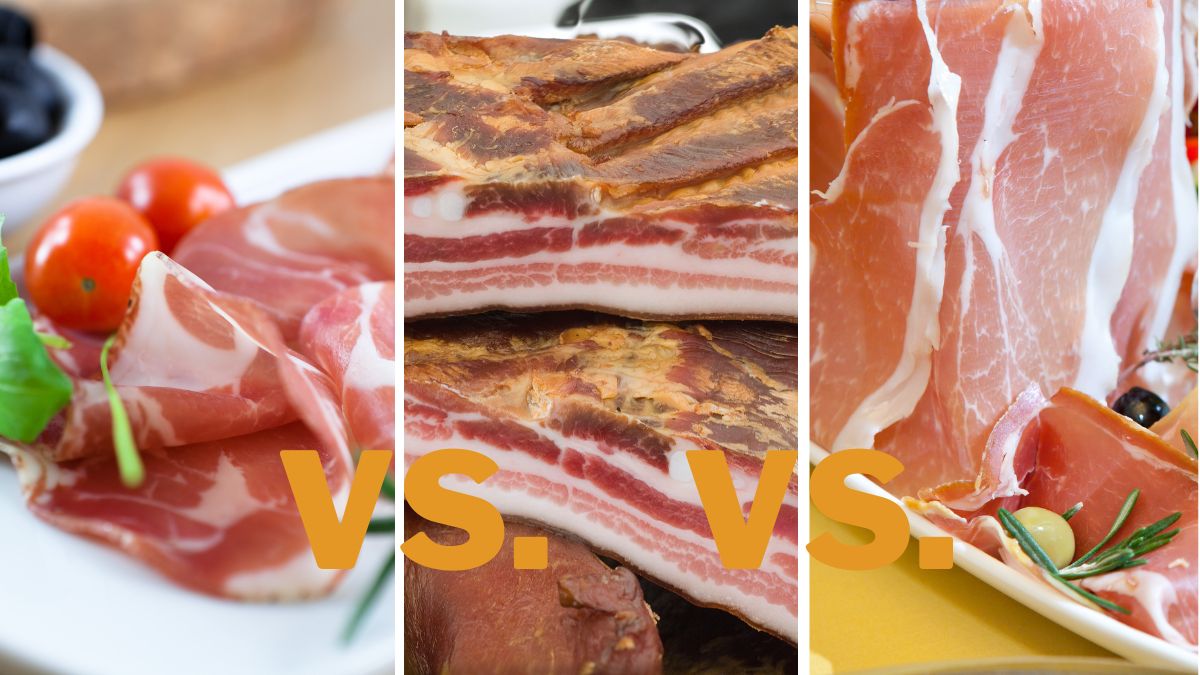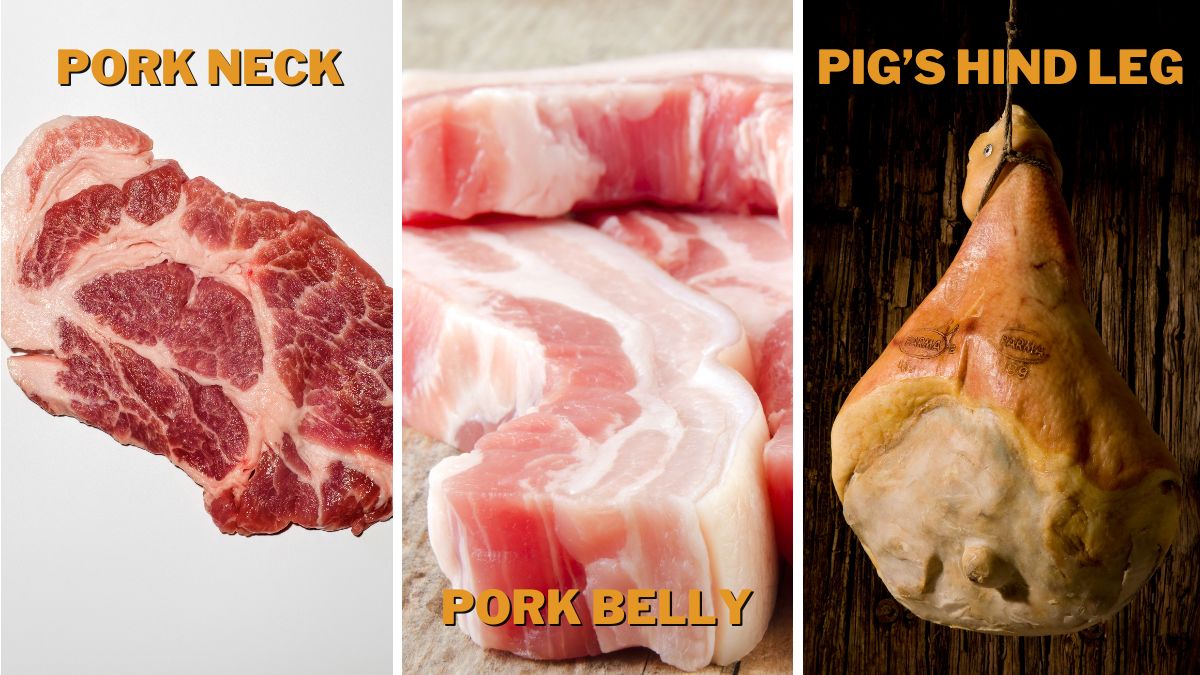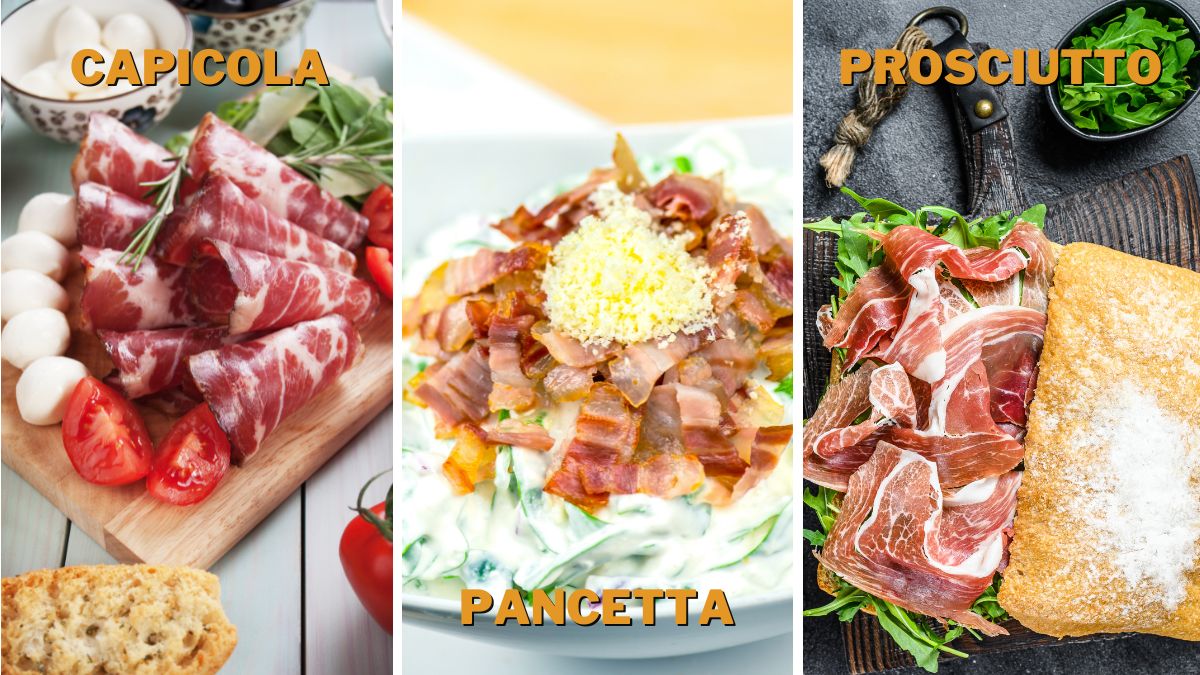Capicola vs. Pancetta vs. Prosciutto: Differences

Taking a bite from a thinly-sliced cured meat is always delightful, but identifying them can be challenging. Unless you’ve seen where the slice came from, chances are each piece is presented altogether on a plate. And because they look pretty similar, it can be difficult to tell which one is capicola, pancetta, or prosciutto.
The most significant difference between capicola, pancetta, and prosciutto is the cut of meat used. Capicola is made from pork shoulder and neck, pancetta is from pork belly, and prosciutto is pork leg.
Of course, visuals alone are not enough to identify them on a plate. For that, you’ll need to learn their history and how they’re made.
Where They Originated From
Capicola, also known as coppa or capocollo, traces its roots back to Southern Italy. It was brought to the region by the Greeks in the 8th Century BC when their influence started spreading during their colonization. The Greeks introduced Southern Italians of the time to pork sausages, giving them the idea to begin the process of capicola.
Calabria and Piacenza are established provinces for capicola-making, even going as far as getting a protected designation for their distinct way of making one.
Pancetta has the same history, having been enjoyed around Italy for centuries. One of its earliest mentions was with the Roman legionnaires when pancetta was included in their food rations. But unlike capicola, where the primary focus is the southern region, pancetta can be found everywhere, with certain provinces putting their twist in the process.
However, the prosciutto’s origins are a bit more varied, unlike the other two. There’s no particular region for prosciutto because it’s heavily dependent on geography; the area needs to be mountainous and close to the sea. Two of the most renowned areas for prosciutto making – Parma in Emilia-Romagna and San Daniele in Friuli – fit this geographical requirement.
Cuts of Meat Used
Despite all three cured meats originating from Italy, they all use different parts of the pig.
Capicola, as mentioned earlier, is made from pork shoulder and neck. Its name gives hints about the type of meat used. “Capo” means “head,” and “collo” means “neck.” These pork cuts are important because capicola must retain tenderness and moisture throughout the curing process.
Meanwhile, pancetta is made from pork belly, just like bacon. The meat is seasoned twice – to let the flavors seep through and to incorporate the flavor throughout the drying process. But unlike bacon, it’s perfectly safe to eat uncooked pancetta.
As for prosciutto, this cured meat is made from the pig’s hind leg – a telltale hint if you ever see a whole, unsliced one. Unlike capicola and pancetta, you won’t see prosciutto as rolled meat because the entire leg section is cured. The downside is that it can take over a year to cure the leg section because of its size and temperature requirements.

Seasonings Used
Because capicola, pancetta, and prosciutto are all cured meats, it’s safe to say that salt is a primary seasoning across all three. Not only does it help establish flavor, but it’s also an essential ingredient for curing. But salt is where their similarities end because they use different seasonings to achieve their signature taste.
To make capicola, the meat is first seasoned with garlic, herbs, spices, and wine before being enclosed in a salt rub. The meat soaks in these flavors for a few weeks before undergoing another re-seasoning session with fennel, paprika, coriander, and other spices. Once the seasoning is complete, the meat goes into a casing before starting its dry-curing process.
Pancetta is easier to season than capicola, although it involves the same two-step seasoning process. First, the pork belly gets a salt and pepper rub, along with other flavorful spices such as coriander and fennel seeds. The meat takes about a week or so to absorb those flavors; after that, it is rinsed and reseasoned with pepper before it starts curing.
Despite taking the longest to finish curing, Prosciutto is the easiest to season. All it needs is a generous salt rub to sit on the pork leg for several weeks. Once the salt draws out excess moisture and imparts its taste, the meat is left to dry, and nature takes over the curing process.
Length of Time Needed to Make Them
Observing the curing time for these three cured meats is fascinating because of how different they are from each other. For instance, capicola typically takes about 8-10 weeks to cure, but you can dry-cure them for up to six months. Meanwhile, creating pancetta takes about a month total – up to 10 days for the initial curing, then another 2-3 weeks for drying.
Prosciutto takes the longest to finish. You can get away with a minimum of 8-16 months if you can maintain the perfect temperature during curing. Some can even go for as long as three years. However, for protected ones like Parma, prosciutto makers are legally required to cure their pork legs for at least 400 days.
How to Serve Them
After spending several weeks or months curing the meat, now comes the fun part: eating them.
Serving capicola and prosciutto are pretty similar – thinly sliced. Remember that prosciutto slices are significantly larger than capicola because of how it’s made.
Capicola slices are versatile, too. They’re great on a charcuterie board, and they’re excellent sandwich meat. I like pairing a slice of capicola with some cheese and crackers – a delicious play of flavors between creaminess and saltiness. And if I were to add it to a sandwich, I can pair it with sliced cheese as a quick meal or scrambled eggs for breakfast.
Prosciutto can be served similarly, but remember that it can be saltier than capicola. After all, prosciutto doesn’t have the same variety of spices used in capicola. It must also be consumed shortly after slicing off the leg, or the sliced portion will become dry and chewy.
Nevertheless, I still enjoy prosciutto in a sandwich, either with cheese or alone. Every once in a while, I even indulge in a little treat: prosciutto-wrapped cheese straws.
Pancetta, by far, is the most versatile of the three. It can be eaten as is or added as a pizza topping, with salads, and even on other dishes. I add it for extra flavor on top of grilled vegetables to give everything a bit of character.

Nutritional Values
As delicious as they are, we must remember that capicola, pancetta, and prosciutto are cured meats – meaning their sodium levels are quite high. The cut of pork used also affects their fat levels, so keep that in mind as well. As always, moderation is key when enjoying decadent treats such as these.
To help us visualize their nutritional values, we’ve created a handy reference table for you. These values are based on 100-gram servings, so adjust accordingly for anything less than 100 grams. [1] [2] [3]
| Label | Capicola | Pancetta | Prosciutto |
| Calories | 123 | 357 | 214 |
| Protein | 19.3 g | 14.29 g | 28.6 g |
| Fat | 3.51 g | 32.14 g | 10.7 g |
| Iron | 0.7 mg | 2.57 mg | 1.29 mg |
| Sodium | 1193 mg | 1643 mg | 1610 mg |
| Cholesterol | 61 mg | 71 mg | 89 mg |
